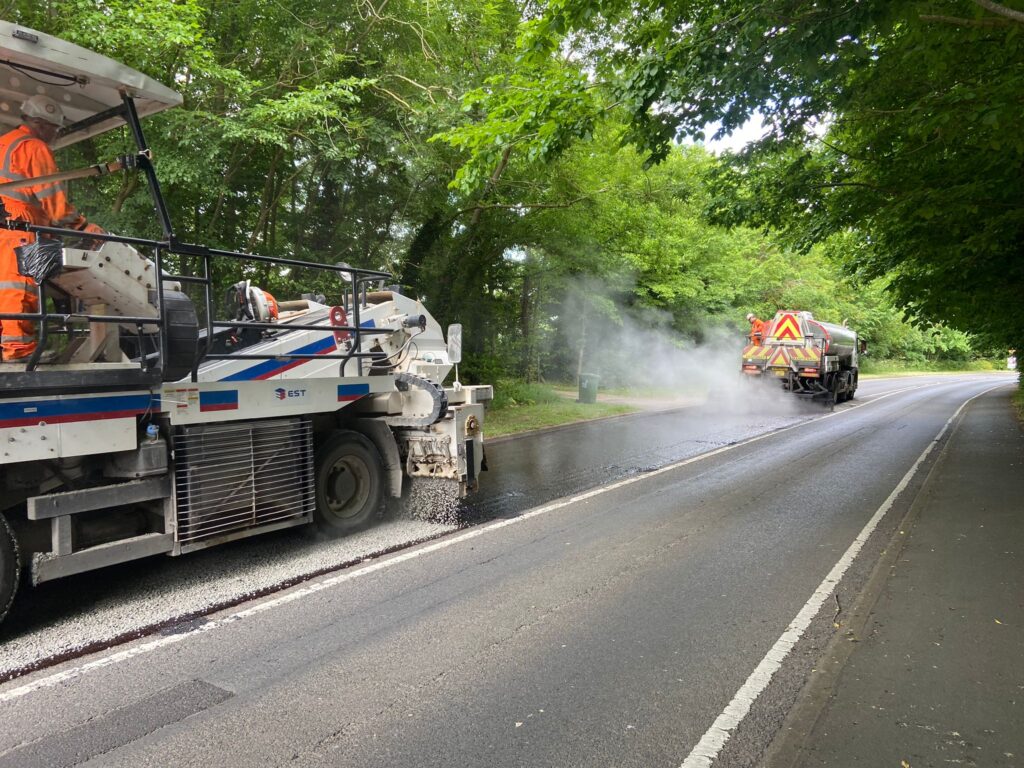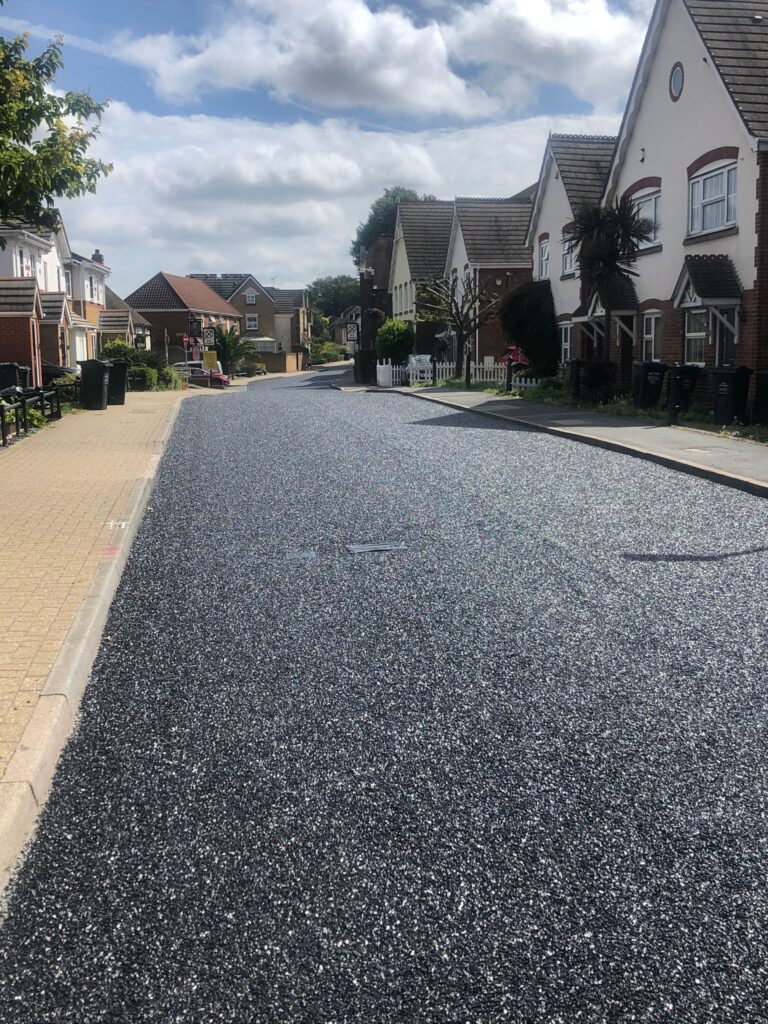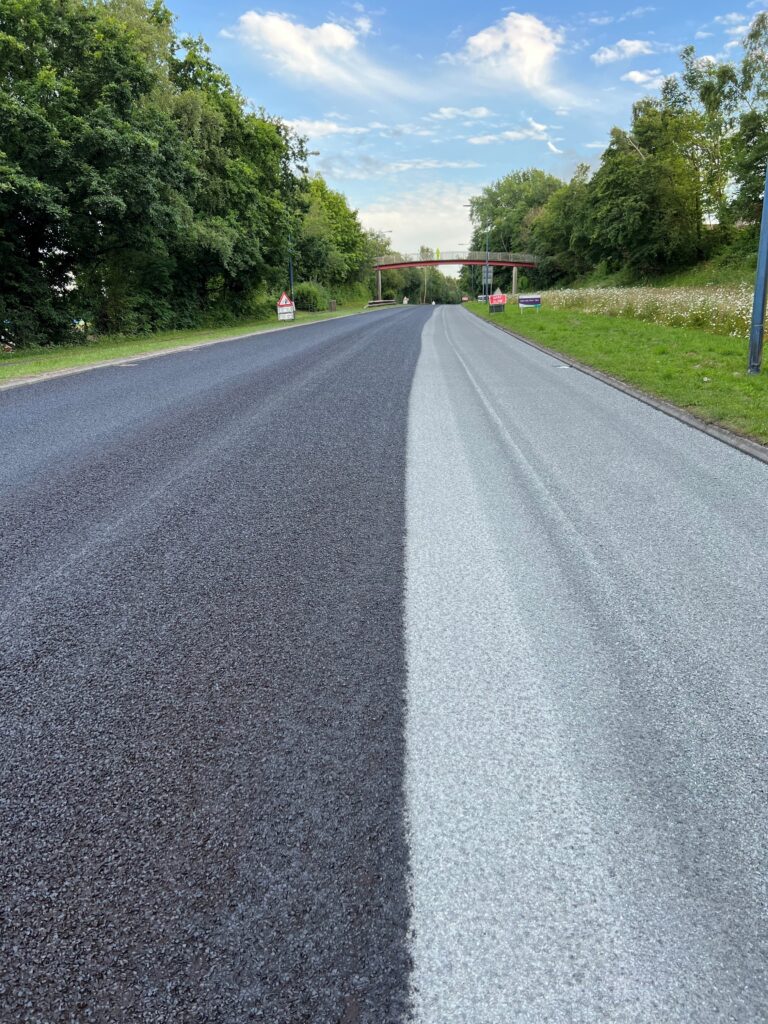Surface dressing is not new. It has been used for many years as a road maintenance treatment to protect and improve the conditions of the road surface. Incredibly, the Road Emulsion Association Limited was formed in 1928 and will be celebrating its centenary year in 2028, having represented the interests of bitumen emulsion producers over this time. And we continue to see new innovations being applied as we reach this amazing milestone.
Firstly, let’s remind ourselves of what surface dressing is, as our main weapon against potholes. It’s a system that applies a bitumen emulsion spray to the existing road surface, followed by the application of stone, or aggregate, which is glued to the bitumen, once the chemical and evaporation process is completed. Then, the emulsion returns to a film of bitumen. The new aggregates provide vital improved skid resistant texture, which is a key road safety feature, and the sprayed bitumen emulsion seals the road surface from water ingress.
Improvements
Over the years, the products, equipment and processes have evolved significantly. From the skilful training of operatives and use of improved durable PPE, to high performing spray machines and aggregates spreaders. Traffic controls and the use of sweepers, or vacuum equipment, are also providing additional safety in the process. So, it’s safe to say we’ve made great strides from an operational perspective.
Further important improvements have undoubtedly been made over the past decades, as we’ve witnessed the increasing use of polymer modification to the bitumen emulsions. Today, the UK sets high standards. Impressively, we use more polymer emulsions in the surface dressing of our local authority roads as a proportion than any other European country.



Challenges
But there are still further challenges. Bitumen can become brittle in extremely cold weather, and it will flow in very hot temperatures. The introduction of elastomeric polymers extends the flexibility of the bitumen base and provides a significant improvement in the ability of the surface dressing to withstand increasing extremes of temperatures. The Polymer Emulsions also have increased adhesion properties to ensure the aggregate is firmly stuck to the polymer modified bitumen layer.
In recent years, we have seen increasingly extreme changes to our climate conditions. In particular, we’ve seen higher and more frequent rainfall, along with increasing summer temperatures. And that’s not good news for our roads.
These changes are challenging all our road networks and materials. Recent data shows the damaging effect of water entering the surface structure of a road and how this can quickly result in deterioration of the road surface. Increasing surface water and modern-day vehicles are the main culprits.
However, we’re pleased to say that the industry has risen to meet these unprecedented challenges. While standard surface dressing is designed to seal the road surface, it has not been used extensively across towns and cities, or the strategic road network. This is due to the impact of certain road designs, and traffic flows, on the structure of the open aggregate interface.
And here’s where we introduce the new star of the show. Perhaps the most important innovation in the history of surface dressing has arisen from the industry researching the challenges ahead. So, the process of encapsulation was invented and continue to see extensive application across the country, as local authorities realise the benefits.
Encapsulation
Encapsulation (or lockdown treatment) is an innovative development to the process of surface dressing which is a ‘game changer’ in the use and application of the surface dressing process.
Encapsulation is effectively an over spray of bitumen emulsion over the finished surface dressing. As with many successful innovations, you may think: “why has no one thought of this before?”. Especially when to the travelling public, it appears just like a brand-new asphalt surface, but at a fraction of the cost. However, encapsulation does much more than look aesthetically pleasing to road users.
Firstly, it doubly seals the road surface from the protection of water ingress. With the inevitable increase in rainfall in future years, this will be paramount in securing the integrity of our road surfaces and therefore playing a key role in preventing pesky potholes.
Encapsulation also locks in the aggregates that form the main texture of a new safe skid resistance surface, provided by surface dressing. This provides greater resistance to the damage of modern power steering vehicles with modern day, more abrasive tyre treads. Moreover, the overspray adds a protective screening to high road surface temperatures and helps resist hot temperature damage.
In summary, encapsulation provides a safe and renewed road surface at a fraction of the financial and environmental cost of removing the old asphalt road and replacing it with new asphalt. And this has to be an innovation worth celebrating.
Importantly, the carbon emissions during the life span of an encapsulated road is significantly lower (RSTA figures) than a road having to be repaired with newly laid asphalt. The new encapsulated road has the equivalent life expectancy of an asphalt road, but at a much lower environmental and physical cost.
